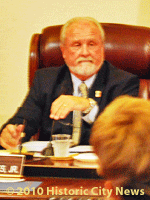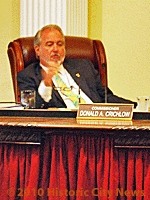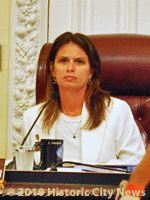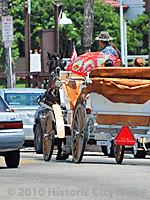 Local Historic City News reporters were on hand during the City Commission Workshop yesterday afternoon for what could be fairly described as the proverbial hornet’s nest — stirred up over what the mayor described as the “premature” publication of a draft carriage ordinance.
Local Historic City News reporters were on hand during the City Commission Workshop yesterday afternoon for what could be fairly described as the proverbial hornet’s nest — stirred up over what the mayor described as the “premature” publication of a draft carriage ordinance.
Mayor Joe Boles spoke first after convening the special workshop at 3:30 p.m. yesterday to discuss publicly the commission’s plan for the future of horse-drawn carriage tours in downtown St. Augustine.
The mood of the filled-to-capacity room was tense and, from the looks on the faces on the five commissioners, I would describe them as unsettled; even nervous. As someone who has watched as a crowd turned into an angry mob, I sensed apprehension in the outnumbered commissioner’s eyes.
Boles was clearly in the spotlight at that moment so he maneuvered to defuse the unrest by declaring that nobody at the city has spoken to him about doing away with the carriages — a fear that he could tell was front-and-center in the minds of the dozen or so carriage drivers attending.
Boles stated his position that he supports having horse-drawn carriages downtown and that he discounts the concerns of animal rights activists that claim the horses are mistreated — although before the meeting concluded, he would listen to several others who felt differently.
Recalling the process used by the city to negotiate ten-year contracts with St. Augustine (Red) Trains and Historic Tours (Green) Trolleys, Boles pointed out that, at that time, discussions were commenced regarding better regulation of the carriages and to provide a fair and even basis for them to be licensed and taxed.
Boles suggested that since there was no “industry input” in constructing the prematurely published draft ordinance, staff should meet privately with the carriage operators to solicit their point of view before any further steps were taken.
Nancy Sikes-Kline spoke, briefly, addressing those who represented the carriage operators concluding that she wanted to see a “happy industry and a happy city”.
Vice Mayor Errol Jones stopped short of endorsing Boles suggestion; stating that he saw one-at-the-time meetings with carriage operators as a “waste of time”. Jones objected to any private meetings with the potential licensees saying, “Don’t meet individually — meet in public.”
Jones put a fine point on the rumors that the city wanted to “take over the carriage business” and “put them out-of-business” saying that an updated licensing procedure is “something the city staff and commission have been talking about for seven or eight years.” Less there be any doubt by the carriage drivers, owners, their attorneys and others lined up to speak, Jones said, “Changes are needed. Changes are coming. Changes are inevitable.”
 Commissioner Don Crichlow asked the crowd to understand that the draft ordinance they read in the paper was not one that had been developed by the commissioners or staff — it was based on the work that had been done “in another city”. The city Crichlow was referring to was Charleston, SC., where City Attorney Ron Brown and his assistant attorney Carlos Mendoza drew example language that was in place and working to be used as “a starting place.”
Commissioner Don Crichlow asked the crowd to understand that the draft ordinance they read in the paper was not one that had been developed by the commissioners or staff — it was based on the work that had been done “in another city”. The city Crichlow was referring to was Charleston, SC., where City Attorney Ron Brown and his assistant attorney Carlos Mendoza drew example language that was in place and working to be used as “a starting place.”
Crichlow pointed out that, of the 20 pages contained in the printed draft, “10 of those pages have been ‘X’ed out.” Crichlow, whose term of office expires this year and is not seeking re-election, believes we need a franchise agreement with the carriages similar to the one we have with the trains and trolleys. “We don’t need something complicated,” Crichlow said.
Crichlow says that part of the problem is that one person’s company owns 43 of the existing 46 carriage permits. The city has been in litigation with Murphy McDaniel and his company, Avalon Carriage, over what McDaniel claimed was Stuart Gamsey’s unfair monopoly of the horse-drawn carriage business in St. Augustine.
Subsequently, with money borrowed from Frederick J. Canevari, McDaniel negotiated to buy out Gamsey’s permits — leaving McDaniel holding a total of 43 of the coveted permits.
“The litigation delayed bringing a proposal for changes to the carriage ordinance,” Crichlow said. “I don’t want to see the carriages go out-of-business, but, the fee they have been paying is outrageous.” Crichlow says he is not for “drastic changes” and he wants to see businesses in the city that are profitable and “make a living”. Any new ordinance that would please Crichlow, in his words, would have to be “simplified … a lot.”
 Commissioner Leanna Freeman said that last night’s meeting was a small step and that there are a lot of steps ahead. Echoing Vice Mayor Jones concerns, Freeman also disagreed with the mayor on sending staff to privately meet with people in the industry. “We need to hear their thoughts,” Freeman said. She also expressed her unhappiness with the language in the draft, but said, “at least we can get the ball rolling.” Freeman also questioned the proposal to have the city operate the “hack stands”.
Commissioner Leanna Freeman said that last night’s meeting was a small step and that there are a lot of steps ahead. Echoing Vice Mayor Jones concerns, Freeman also disagreed with the mayor on sending staff to privately meet with people in the industry. “We need to hear their thoughts,” Freeman said. She also expressed her unhappiness with the language in the draft, but said, “at least we can get the ball rolling.” Freeman also questioned the proposal to have the city operate the “hack stands”.
Before the workshop went much further, the Mayor announced that the proposed ordinance, as it had been published in a local newspaper, was “off the table”, so there was no need for the public to debate it in the workshop; again reassuring those in the audience that there will be plenty of opportunity in the future to speak before the commission prior to any actual ordinance being enacted.
“There is no reason for the city to get riled up,” Boles said. “Don’t consider (the proposed ordinance) until there is an opportunity for input.”
Jones interjected, “Don’t panic!” He said that he see a few issues that will have to be addressed; the first being that we, as a city, want to continue having carriages downtown. Once that premise is established, it’s time to look at the maximum number of carriages that can be on the street at any one time, then the maximum number of medallions that can be issued to one owner and the cost to be paid by the owner to operate on the public streets.
Jones suggested that whatever fee might be decided could be “incremental”; giving as an example that the operator might pay $500 the first year, then $1,000 or $1,500 the second year and then, perhaps, $2,000 a year after that.
“Location will have to be discussed, as well,” Jones said. “And, the sale or transfer of the license.” The propriety and investment in carriage permits has been at the center of much of the controversy in the evolution of this debate. Carriage operators, unlike train and trolley operators, have no franchise from the city. The permits have been leased, bought and sold through the years for hundreds of thousands of dollars — paid for a permit sold by the city for only $80 per year.
Heritage Tourism director Dana Ste. Claire, who formerly managed the local trolley operated by Historic Tours of America, said that his department views the trains and trolleys as “partners with the city.” Ste. Claire said he did not think the city was interested in “over-regulating businesses in the city.” In his view, Ste. Claire sees all of the city businesses driven to one common goal, “Our business plan is about improving the visitor experience, and one visitor expectation is our horses and carriages.”
 Carlos Mendoza gave a brief overview of where the city attorney’s office has been and is going since the mid 1970’s in the debate over permits vs. franchises for horse-drawn carriages. Mendoza says that his office has been in communications with Martha Graham in the Department of Public Works, and others to determine the real cost to the city in terms of “maintenance and repairs that aren’t required generally.” Mendoza said that they determined that there is “more maintenance with carriages present, the maintenance is significantly different, there is more cleaning and street sweeping required for sanitary reasons and to attempt to control offensive smells and generally more man power hours devoted to these tasks.”
Carlos Mendoza gave a brief overview of where the city attorney’s office has been and is going since the mid 1970’s in the debate over permits vs. franchises for horse-drawn carriages. Mendoza says that his office has been in communications with Martha Graham in the Department of Public Works, and others to determine the real cost to the city in terms of “maintenance and repairs that aren’t required generally.” Mendoza said that they determined that there is “more maintenance with carriages present, the maintenance is significantly different, there is more cleaning and street sweeping required for sanitary reasons and to attempt to control offensive smells and generally more man power hours devoted to these tasks.”
At the end of the staff presentations, it was decided to divide the remaining 45 minutes before the scheduled regular meeting of the commission to hear any public comment up to one and a half minutes each.
The workshop closed and was adjourned at 4:45 with instructions to staff to come up with a plan that allows more input from the industry but without any further action taken at that time.
Photo credit: © 2010 Historic City News staff photographer
Discover more from HISTORIC CITY NEWS
Subscribe to get the latest posts sent to your email.
